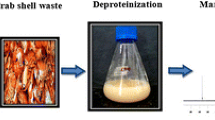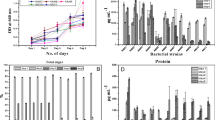Abstract
Controlling bacterial biofilms is a major target for industrial processes and thus is a tedious task under study in many research proceedings. The algal associated bacterial isolates from Unai Mata hot water spring, Gujarat, India, were screened for production of potent amylases, proteases and biosurfactants. The partially purified biomolecules were checked for effects of substrate concentration, cations and stability at extreme physical conditions like temperature (50 ℃) and acidic pH (5 and 6). Metal ions namely—Cu and Zn for amylase, while Zn and Na for protease, were found to be yielding least and highest activities, respectively. Best three isolates were selected for potential biomolecule production and sequenced for 16 s rDNA gene. The three isolates were found to be Stenotrophomonas sp. strain T1UM1, Pantoea sp. strain T1UM4 and Bacillus sp. strain T1UM8 with GenBank accession number MH764436, MH764437 and MH764438, respectively. The partially purified biomolecules cocktail showed effective antibiofilm activities at concentration of 1, 2, 5 and 10 U/ml or mg/ml against various bacteria tested at 1, 2 and 5 h treatments. The effects were different on the type of bacterium containing a combination of specific biomolecules. Thus, biomolecule cocktail reported here from hot water spring isolates has antibiofilm application potential in industries.




Similar content being viewed by others
References
Ashitha A, Radhakrishnan EK, Jyothis M (2020) Characterization of biosurfactant produced by the endophyte Burkholderia sp. WYAT7 and evaluation of its antibacterial and antibiofilm potentials. J Biotechnol 313:1–10. https://doi.org/10.1016/j.jbiotec.2020.03.005
Markande AR, Nerurkar AS (2019) Microbial Bioemulsifiers and Their Role in the Natural Environment. In: Katiyar V, Joshi A (eds) MICROBIAL RESEARCH : An Overview. International Publishing House Pvt. Ltd., I. K, pp 1–21
Gutiérrez TJ (2019) Antibiofilm enzymes as an emerging technology for food quality and safety. Enzymes in Food Biotechnology: Production, Applications, and Future Prospects. Elsevier Inc., Amsterdam, pp 321–342
Patel RJ, Patel KR (eds) (2016) Experimental Microbiology, vol 1. Aditya, Ahmedabad
Markande AR, Nerurkar AS (2016) Microcosm-based interaction studies between members of two ecophysiological groups of bioemulsifier producer and a hydrocarbon degrader from the Indian intertidal zone. Environ Sci Pollut Res 23:14462–14471. https://doi.org/10.1007/s11356-016-6625-1
Desai C, Patel P, Markande AR et al (2020) Exploration of haloarchaea for their potential applications in food industry. Int J Environ Sci Technol 17:4455–4464. https://doi.org/10.1007/s13762-020-02773-2
Markande AR, Acharya SR, Nerurkar AS (2013) Physicochemical characterization of a thermostable glycoprotein bioemulsifier from Solibacillus silvestris AM1. Process Biochem 48:1800–1808. https://doi.org/10.1016/j.procbio.2013.08.017
Markande AR, Nerurkar AS (2021) Analysis of nutritional factors influencing the biosynthesis of amyloid bioemulsifier BE-AM1 applicable in food industry. J Microbiol Biotechnol Food Sci 11:1–10
Kumar S, Stecher G, Tamura K (2016) MEGA7: molecular evolutionary genetics analysis version 7.0 for bigger datasets. Mol Biol Evol 33:1870–1874. https://doi.org/10.1093/molbev/msw054
Markande AR, Nerurkar AS (2016) Bioemulsifier (BE-AM1) produced by Solibacillus silvestris AM1 is a functional amyloid that modulates bacterial cell-surface properties. Biofouling 32:1153–1162. https://doi.org/10.1080/08927014.2016.1232716
Ohadi M, Forootanfar H, Dehghannoudeh G et al (2020) Antimicrobial, anti-biofilm, and anti-proliferative activities of lipopeptide biosurfactant produced by Acinetobacter junii B6. Microb Pathog 138:103806. https://doi.org/10.1016/j.micpath.2019.103806
Jee SC, Kim M, Sung JS, Kadam AA (2020) Efficient biofilms eradication by enzymatic-cocktail of pancreatic protease type-I and bacterial α-amylase. Polymers (Basel) 12:1–13
Sharma S, Surbhi V, Bilqeesa B et al (2019) Thermostable enzymes for industrial biotechnology. In: Elsevier BV (ed) Biomass, Biofuels, Biochemicals: Advances in Enzyme Technology. pp 469–495
Desai C, Shaikh M, Markande AR (2017) Extreamozymes—A Review. Int J Sci Res Sci Technol 3:531–535
Schuler CG, Havig JR, Hamilton TL (2017) Hot spring microbial community composition, morphology and carbon fixation: implications for interpreting the ancient rock record. Front Earth Sci 5:1–17. https://doi.org/10.3389/feart.2017.00097
Chaudhary N, Prabhu S (2016) Thermophilic actinomycetes from hot water spring capable of producing enzymes of industrial importance. Int J Res Stud Biosci 4:29–35. https://doi.org/10.20431/2349-0365.0406005
Schultz J, Rosado AS (2020) Extreme environments: a source of biosurfactants for biotechnological applications. Extremophiles 24:189–206. https://doi.org/10.1007/s00792-019-01151-2
Ardhi A, Sidauruk AN, Suraya N et al (2020) Molecular identification of amylase-producing thermophilic bacteria isolated from Bukit Gadang Hot Spring, West Sumatra, Indonesia. Biodiversitas 21:994–1000. https://doi.org/10.13057/biodiv/d210319
Msarah MJ, Ibrahim I, Hamid AA, Aqma WS (2020) Optimisation and production of alpha amylase from thermophilic Bacillus spp. and its application in food waste biodegradation. Heliyon 6:e04183. https://doi.org/10.1016/j.heliyon.2020.e04183
Lee JH, Kim YG, Lee J (2018) Thermostable xylanase inhibits and disassembles Pseudomonas aeruginosa biofilms. Biofouling 34:346–356. https://doi.org/10.1080/08927014.2018.1440551
Pathak AP, Rathod MG (2017) Exploration of a hot spring for thermostable protease producers. J Microbiol Biotechnol Food Sci 7:101–109. https://doi.org/10.15414/jmbfs.2017.7.2.101-109
Suleiman AD, Abdul Rahman N, Mohd Yusof H et al (2020) Effect of cultural conditions on protease production by a Thermophilic Geobacillus thermoglucosidasius SKF4 isolated from Sungai klah hot spring park, Malaysia. Molecules 25:1–14. https://doi.org/10.3390/molecules25112609
Elamary R, Salem WM (2020) Optimizing and purifying extracellular amylase from soil bacteria to inhibit clinical biofilm-forming bacteria. Peer J 8:e10288. https://doi.org/10.7717/peerj.10288
Khambhaty Y, Plumb J (2011) Characterization of bacterial population associated with a brackish water desalination membrane. Desalination 269:35–40. https://doi.org/10.1016/j.desal.2010.10.039
Ryan RP, Monchy S, Cardinale M et al (2009) The versatility and adaptation of bacteria from the genus Stenotrophomonas. Nat Rev Microbiol 7:514–525. https://doi.org/10.1038/nrmicro2163
An S, qi, Berg G, (2018) Stenotrophomonas maltophilia. Trends Microbiol 26:637–638. https://doi.org/10.1016/j.tim.2018.04.006
Feng Y, Shen D, Song W (2006) Rice endophyte Pantoea agglomerans YS19 promotes host plant growth and affects allocations of host photosynthates. J Appl Microbiol 100:938–945. https://doi.org/10.1111/j.1365-2672.2006.02843.x
Wright SAI, Zumoff CH, Schneider L, Beer SV (2001) Pantoea agglomerans strain-EH318 produces two antibiotics that inhibit Erwinia amylovora in vitro. Appl Environ Microbiol 67:284–292. https://doi.org/10.1128/AEM.67.1.284-292.2001
Aldujaili NH, Alrufa MM, Sahib FH (2017) Antibiofilm antibacterial and antioxidant activity of biosynthesized silver nanoparticles using Pantoea agglomerans. J Pharm Sci Res 9:1220–1228
Zhao Y, Chen C, Gu HJ et al (2019) Characterization of the genome feature and toxic capacity of a Bacillus wiedmannii isolate from the hydrothermal field in Okinawa trough. Front Cell Infect Microbiol 9:1–13. https://doi.org/10.3389/fcimb.2019.00370
Acknowledgements
The authors would like to thank the Provost and administrative staff from Uka Tarsadia University for their financial support (Research Promotion Scheme) during the work and for their constant support.
Author information
Authors and Affiliations
Contributions
MS, DP and SD worked on Amylase, Biosurfactants and Protease production, respectively, under the guidance of AM who also prepared the basic manuscript.
Corresponding author
Ethics declarations
Conflict of interest
The authors declare that they have no conflict of interest.
Additional information
Publisher's Note
Springer Nature remains neutral with regard to jurisdictional claims in published maps and institutional affiliations.
Significance statement Use of biomolecules from extreme condition isolates yields immense industrial potential as they are expected to be viable for a wide range of temperatures and pH. The present report of enzymatic and biosurfactant cocktails for the removal of biofilms has potent industrial and environmental applications.
Rights and permissions
Springer Nature or its licensor holds exclusive rights to this article under a publishing agreement with the author(s) or other rightsholder(s); author self-archiving of the accepted manuscript version of this article is solely governed by the terms of such publishing agreement and applicable law.
About this article
Cite this article
Shaikh, M.K., Patel, D.D., Dobariya, S.C. et al. Evaluation of Thermostable Biomolecule Cocktail from Algal-associated Hot Water Spring Bacteria for Antibiofilm Activities. Proc. Natl. Acad. Sci., India, Sect. B Biol. Sci. 93, 409–418 (2023). https://doi.org/10.1007/s40011-022-01432-5
Received:
Revised:
Accepted:
Published:
Issue Date:
DOI: https://doi.org/10.1007/s40011-022-01432-5




